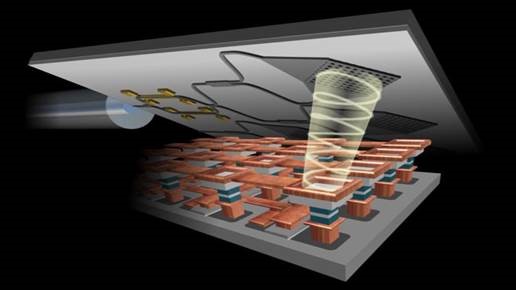2 years postdoc position opening at SPINTEC in the framework of the H2020 EU FET-OPEN SPICE (2017-2020) project on
“Development of optically sensitive storage layer materials to be integrated in magnetic tunnel junctions”
Spin Transfer Torque Random Access Memories (STT-RAM) are focusing an increasing interest in microelectronics industry due to their non-volatility, speed, density, downsize scalability to below 20nm nodes, infinite endurance plus radiation hardness. Major microelectronics companies are aiming at DRAM replacement by STTRAM below the 20nm technology node. An interesting trend that improves the write speed and power of such spintronic memory is the discovery of magnetization reversal by femtosecond laser pulses in thin ferromagnetic Gd/Fe/Co films. Recent results show that a wide class of magnetic materials can be switched in this way. The origin of this optical switching in ferrimagnetic alloys is not clearly established, and initial explanations attribute the effect to ultra-fast heating of spin sub-lattices. This thermally induced switching has been demonstrated in rare earth and transition metal alloys: Gd/Fe/Co and Tb/Co, having an antiferromagnetic coupling between the sub-lattices with distinct demagnetization times for each of them.
The purpose of this post-doctoral project will be to develop optically sensitive storage layer materials that can be integrated in traditional tunnel junction pillar stacks to be used as MRAM cells. The aim is to realize cell switching by optical pulses alone or assisted by electrical current pulses. Development of rare earth/ferromagnetic multilayers of Pt/Co or Tb/Co are the study starting points to bring magneto-optic interaction to the field of spintronics. MTJ fabrication will explore various scenarios of photonics-assisted switching, where the optical pulses are used for heating up the MTJ, while simultaneously sending an electrical ‘write’ current through the MTJ. The developed materials are to be optimized and integrated as an optically-switched layerstack. The aim is to realize an optically switchable magnetization layer in an MTJ stack, having a switching fluence comparable with state of the art for single layers. This work is part of a 4 year EU FET-open project “SPICE” funded in the framework of Future and Emerging Technologies (FET) program. The applicant should have a good background in magnetism and deposition of magnetic/magneto-optic materials as well as good experimental skills.
Applications with detailed CV, letter of motivation and preferably two recommendation letters should be sent by email to lucian.prejbeanu@cea.fr.

